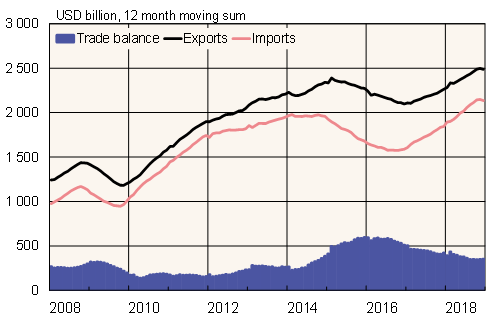BOFIT Weekly Review 03/2019
China’s export and import growth turned negative in December
Following strong growth in the early autumn, growth of China’s foreign trade slowed significantly already in November. In December, the value of goods exports measured in dollars was down 5 % y-o-y, while imports declined by nearly 8 % y-o-y. The value of exports for all of 2018, however, was still up by 10 % and the value of imports up 16 % from 2017. The goods trade surplus fell from about 420 billion dollars in 2017 to around 352 billion dollars last year.
China saw sluggish export growth in all of its main markets. Exports to the United States, which accounts for 18 % of China’s exports, dropped by 4 % in December. Growth in exports to the EU (17 % share) also slowed over the past two months. December exports to the EU matched the December 2017 level. Growth in exports to Japan (6 % share) were down 1 % y-o-y, while exports to Hong Kong (12 % share), which is an important hub of re-exports, declined 25 % from its December 2017 level. The trends reflect both the impact of the US-China trade war and uncertainty in the global economy.
The sharp slowdown in import growth reflects both the general slowing of the Chinese economy and global developments. While December commodity prices were slightly lower on average than in December 2017, most of the fall in imports stemmed from other causes as imports from the US (-36 %), South Korea (-18 %) and Japan (-11 %) all declined much more than the average. Imports from the EU were down 3 % y-o-y.
Besides China’s weak domestic demand, the drop in imports reflects developments in international production chains. Imports and exports related to processing trade for November and December were much weaker than average.
Chinese foreign trade in goods

Source: CEIC.